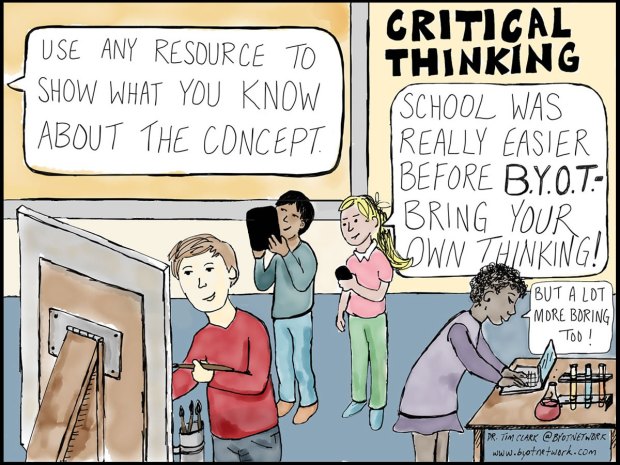
This post is part of a series about the Building Blocks for Personalized Learning. The building block of Critical Thinking helps to construct a firm foundation for personalized learning. In many classrooms, teachers don’t provide the time necessary for critical thinking in order to develop original solutions to problems. Many of the problems that are provided to students also have only one possible right or wrong answer and don’t encourage true critical thinking. When students are given the opportunity to utilize all of the resources available within a classroom (including their own ingenuity) to solve problems, they can be challenged to personally connect to their learning and construct new understanding.
Strategies for Promoting Critical Thinking
Provide Time for Reflection – After being presented with unfamiliar content and ideas, students need time so that they can accommodate that new information within their previously developed schema of that topic. This process involves making sense of new concepts by constructing or reconstructing personal frameworks of thought. Solely telling students to accept the information and moving on to new content doesn’t enable them to work through this process. Students can reflect in a variety of ways, and an effective practice for reflection is for students to learn what ways best help them to make sense of new information. Some strategies could include drawing an illustration; creating a mind map or graphic to understand how concepts are interrelated; or restating information in your own words and making a recording for playback.
Ask Open-Ended Questions – Essential questions proposed at the beginning of a lesson can set the stage for new learning and helps students focus on the core components of a concept or process. This practice helps students answer why they should be learning this information and explains why they should give it their attention. Personalizing the questions will again help students become more connected to that content, so they should also learn how to ask their own questions about topics. Effective questioning for both teachers and students requires practice. Closed questions have one right or wrong answer, and it is virtually impossible to connect to those questions personally. Open questions provide students with opportunities to answer them in a variety of ways based on personal experiences and understandings. Encourage students to provide evidence to support their thinking as they answer open questions to reinforce the connection between personal experience and new content.
Design Rigorous Assignments – So much time in school is spent doing rote types of assignments and activities that involve answering closed questions – completing worksheets, taking notes, etc. Rigorous assignments are those that stretch student thinking with complexity, intricacy, and divergency. Even when teachers have students complete projects or hands-on activities, many of the steps for completing those assignments are pre-determined by the teacher and often stifle true critical thinking. Having students design their own strategies for showing their thinking adds rigor to an assignment. Exploring and discovering new processes for using tools (such as technology) can also add complexity to learning tasks – and promotes effective digital learning, rather than just digitized learning. This practice is often a struggle for many students, especially because many of them are unused to being asked to really think in school. Initially, teachers may have to model the process of critical thinking for students in order to scaffold steps for completing a rigorous assignment.
Expect Every Child to Contribute – When posing questions to students, teachers sometimes rely on the first few responses from a couple of students and proceed to additional concepts. Struggling or introverted students begin relying on others to answer all of the questions in class while they remain silent. This practice keeps them from thinking critically about the content. Every student needs to grapple with the information and contribute to the collective understanding of each concept. Using a student response system can provide each student with a voice and assist in sharing ideas. Likewise, synchronous and asynchronous participation in discussion forums can also serve to help students process their thinking about what they are learning. Even having students turn to each other and discuss new information or to answer an open question and then share their thinking with the class provides a greater opportunity for participation.
Provide Multiple Ways to Show Understanding – Having every student utilize the same application or complete the same process to show their understanding can limit opportunities for critical thinking. Providing multiple ways to show understanding can enable students to think through the process or the application that better meets their individual needs or capitalizes on their personal strengths or interests. Again, it can be daunting for students to learn all of the possible ways that they could show what they know, but teachers can help facilitate this process by providing choices, modeling thinking, and being open to a variety of learning strategies. Engaging students in the process of developing a rubric for evaluating their thinking and assignments can also support personalized learning.
There are many more strategies for encouraging critical thinking in classrooms, but teachers can begin utilizing the five strategies described above for personalizing the learning experience for students. As with any strategy implemented with fidelity, on-going practice and support will also help both teachers and students develop more expertise in critical thinking.